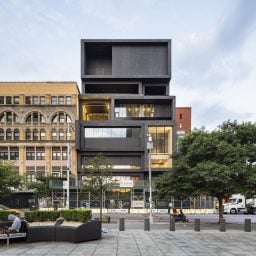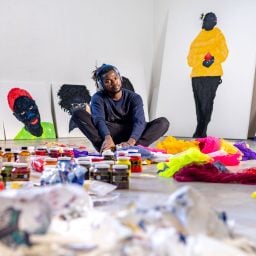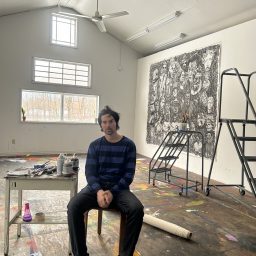New York-based Haitian-born artist Jeffrey Meris (b. 1991) is as much an engineer as an artist. His sculptural assemblages, often based on his own physical body, probe the legacy of trauma experienced by Black communities around the world, and more recently, propose ways of healing through a process of regeneration.
Raised in the Bahamas, and currently based in New York as an artist-in-residence in the Studio Museum’s esteemed program, Meris is currently preparing to exhibit work as part of the group show “Emancipation: The Unfinished Project of Liberation” at the Amon Carter Museum of American Art in Fort Worth, Texas. Meris—along with artists Sadie Barnette, Hugh Hayden, Maya Freelon, Letitia Huckaby, Alfred Conteh, and Sable Elyse Smith—has been asked to respond to the 19th-century bronze sculpture The Freedman by John Quincy Adams Ward. The work depicts a Black man who has just broken free from his literal shackles, though the specter of his enslavement remains. The museum’s particular edition of the bronze cast features a key that springs the subject free from his chains.
Meris’s response to the work builds off of his 2020 sculpture The Block is Hot, a kinetic work featuring a cast of his own torso welded to a perforated sheet metal structure; a mechanized system weighed down by a cinderblock moves the Christlike torso up and down. The work is a personal response to incidents of racial profiling and references elements of Meris’s childhood in the Caribbean, the architecture of class, and Lil Wayne’s debut 1999 studio album, from which it takes its name. The work questions the tropes of masculinity and violence that are inherent in cultures around the world.
Ahead of his participation in “Emancipation,” which opens on March 12, Meris took some time to walk us through his studio.
Tell us about your studio. Where is it, how did you find it, and what kind of space is it?
I am currently an artist-in-residence at the Studio Museum in Harlem, located in New York City. The residency welcomes three artists of African and Afro-Latinx descent through an open application process, and so I am jointly in residence with artists Devin Morris and Charisse Pearlina Weston. This residency has been a dream come true. Since undergraduate studying with Karyn Olivier—who is also an alum of Studio Museum (2005–2006)—I knew that ultimately I wanted to be here.
Do you have studio assistants or other team members working with you? What do they do?
I work with Mena Henry, the lead at Proptogroup, a fabrication studio in New Haven. Alex Murdoch, a friend who I met during my time living in New Haven, also assists me periodically with fabrication needs; so do Stephen Callender and Nicholas Oh.
In the past, I’ve worked with various assistants who’ve all gone on to do wonderful things with their careers as artists. MakeHaven, Gutenberg Arts, and Socrates Sculpture Park are among some of the spaces that provide me with facilities support. It takes a village.
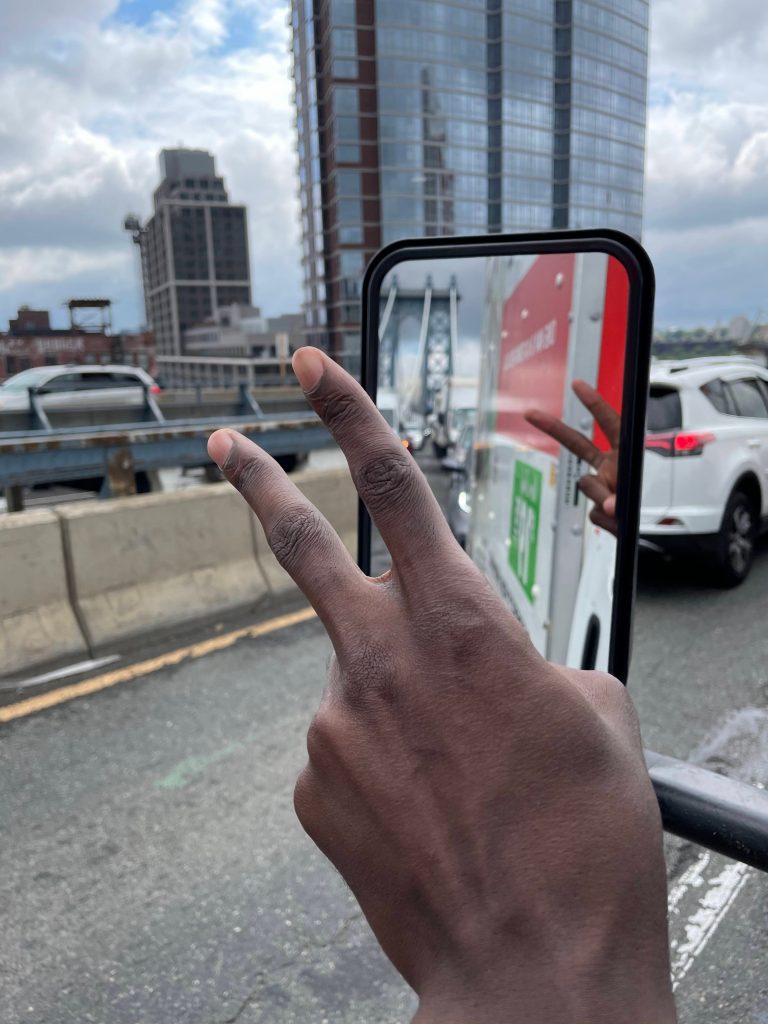
I’ve included a U-Haul picture because so much of my practice is actually driving around the Tri-state area. Courtesy of the artist.
How many hours do you typically spend in the studio, what time of day do you feel most productive, and what activities fill the majority of that time?
Rirkrit Tiravanija was one of my core faculty during my time in graduate school at Columbia University; his philosophy around what is considered studio practice really changed my relationship to work.
Sure, I do have a formal studio with two doors and four walls, but this doesn’t encompass the broad range of projects being fabricated elsewhere or ideas constantly churning in my head. Artists are always thinking about art, always thinking about material, always thinking about ideas, so in many ways; it’s hard to quantify hours or even time in relation to studio and productivity.
What is the first thing you do when you walk into your studio (after turning on the lights)?
I spend the first hour (sometimes much more than I am willing to admit) doing administrative work. Being an artist is not as glamorous as Instagram or the CV makes it look. I saw a meme recently about how the fight or flight response was a life survival mechanism not meant to be triggered when answering emails, and I’ve truly never related to internet culture more.
What is a studio task on your agenda this week that you are most looking forward to?
I am working on this geodesic sphere for an installation. I am terrible at math (I’m the friend that pulls out a calculator to figure out the tip percentage after a meal lol) and this kind of structure requires precession and lots of fabrication. This is what I think is most interesting about making sculpture and where my practice currently is, figuring it out despite the many challenges.
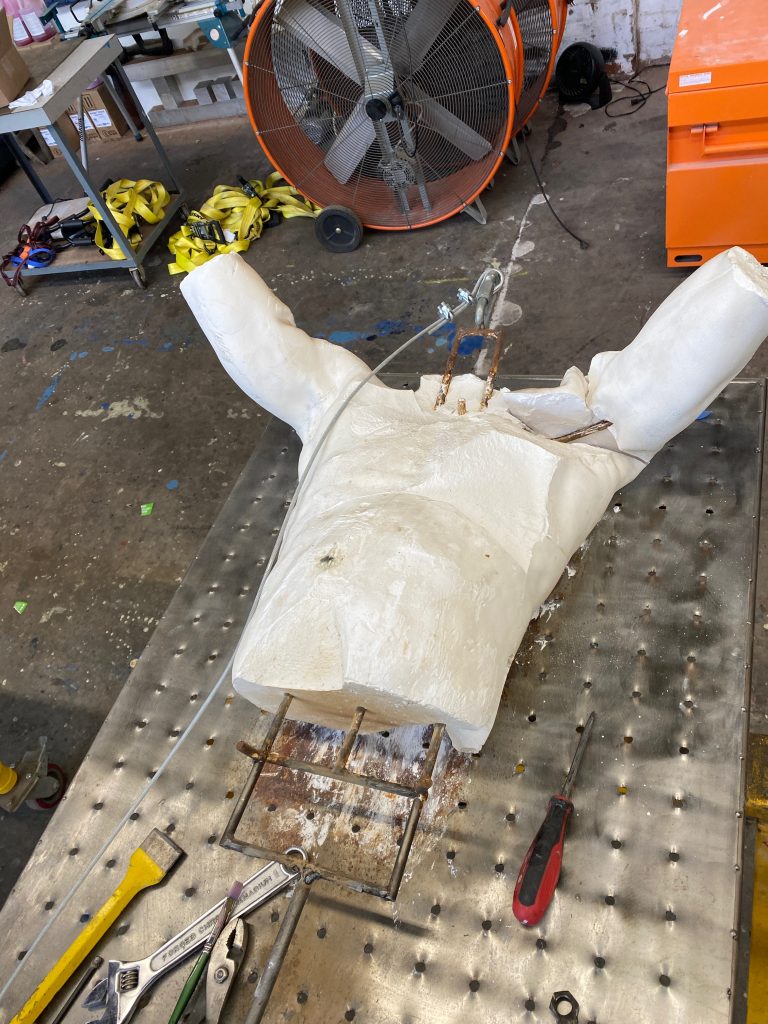
A progress shot of Jeffrey Meris’s The Block is Hot: the Resurrection. Photo by Mena Henry. Courtesy of the artist and Proptogroup.
What are you working on right now? Please send us a few smartphone shots of a work in progress—or photos of different works in various states of completion—in a way that you think will provide insight into your process.
I am working with Mena Henry to reimagine The Block is Hot: the Resurrection for the “Emancipation: The Unfinished Project of Liberation” at the Amon Carter Museum in Fort Worth, Texas.
I’ll be exhibiting The Block is Hot: the Resurrection, A still tongue keeps a wise head, and I, Used to Be XVI, XVII, XVIII in the show. These kinetic sculptures and drawings deal with the body and specifically with the violence of the white gaze on Black people. The casts which are replicas of my body act as containers for racially charged information. Through their self-destruction, the works liberate themselves from mythologies around Blackness.
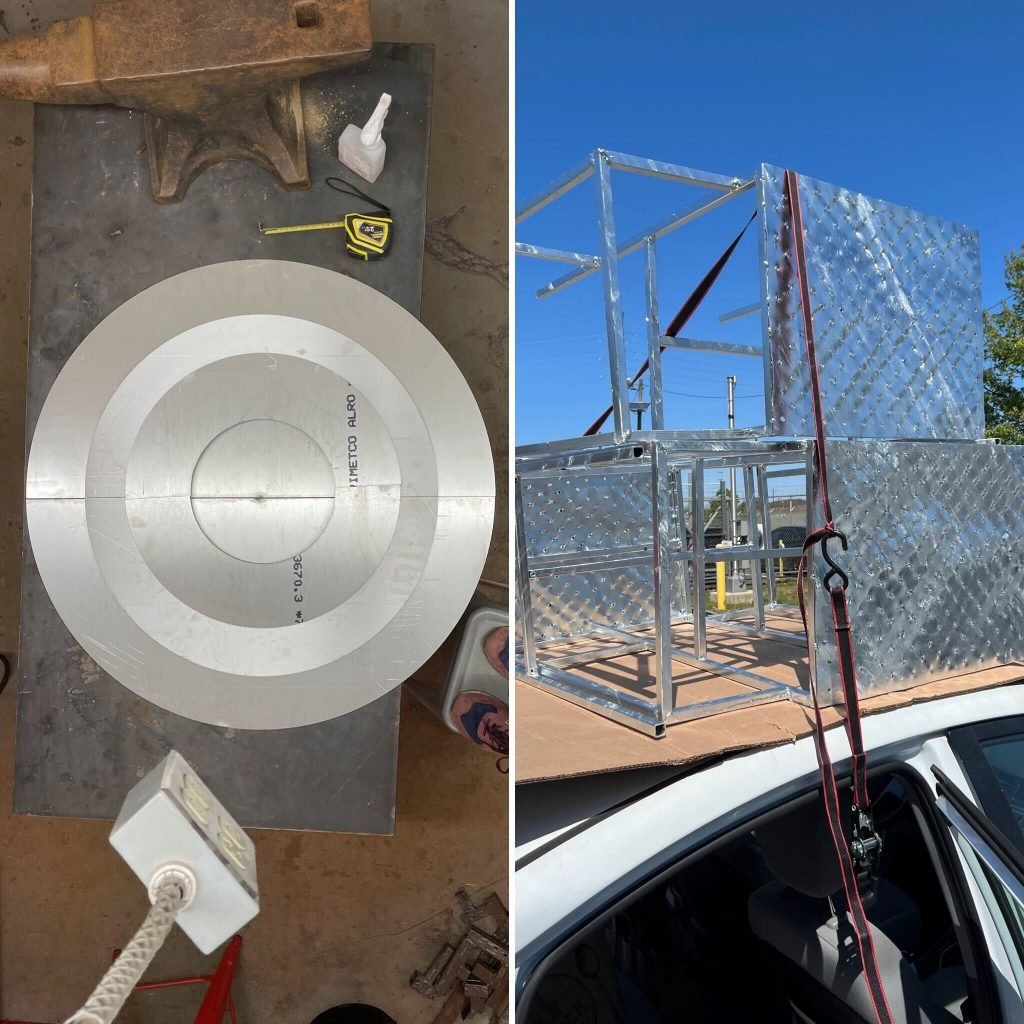
Left: Aluminum discs that Meris cut on the Waterjet. Right: Meris’s car, Betsy White. Courtesy of the artist.
What tool or art supply do you enjoy working with the most, and why? Please send us a snap of it.
MakeHaven has this really amazing CNC Waterjet. This machine uses pressurized water and garnet to cut through virtually any material along an xy axis. The CNC Waterjet changed my practice substantially. The only downside is that MakeHaven is in New Haven, which brings me to my second favorite tool, my car. She’s old and white so I call her Betsy White.
Most of my friends think that I am crazy for owning a car in New York City but then I can do cool things like work on ceramics in Harlem and get it fired in New Jersey or cut aluminum in Connecticut and finish assembly in my studio in Harlem.
How do you know when an artwork you are working on is clicking? How do you know when an artwork you are working on is a dud?
I look back two or three years later and I either think of it fondly or I am too embarrassed to even mention that I ever did that. Paintings from Jeffrey when he was 19, yikes.
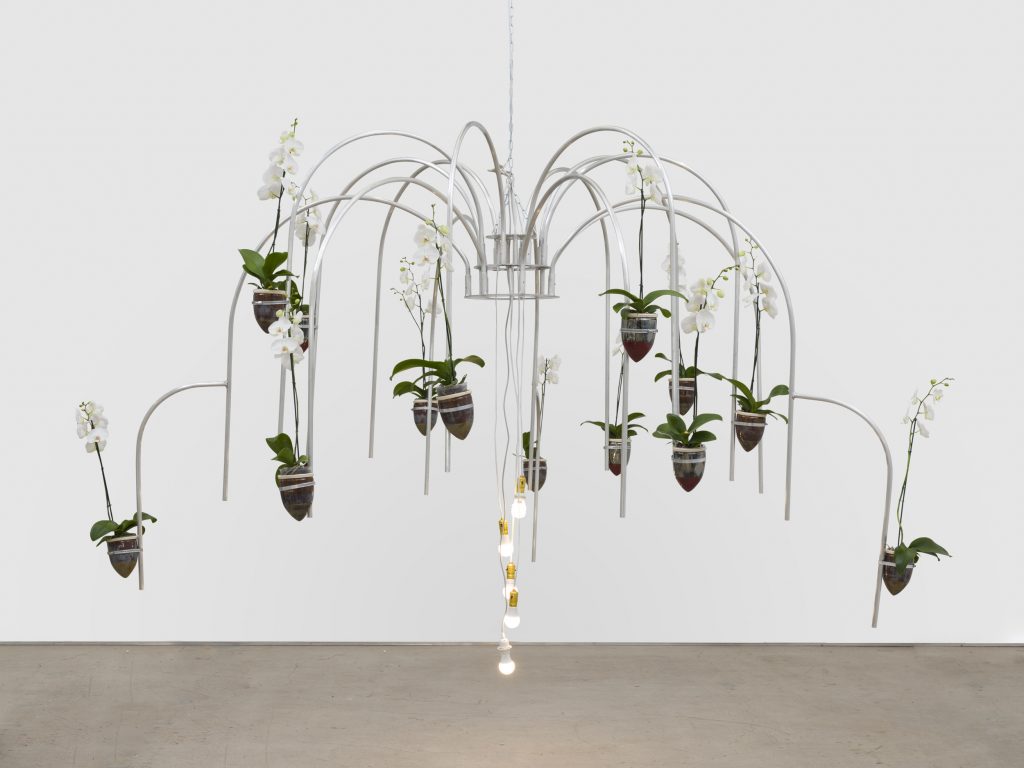
Installation view, “✨be ever wonderful✨” at
Matthew Brown Gallery, Los Angeles. Jeffrey
Meris, Catch a Stick of Fire III (2022). Courtesy of the
artist and Matthew Brown Gallery.
When you feel stuck while preparing for a show, what do you do to get unstuck?
I work out.
What’s the last museum exhibition or gallery show you saw that really affected you and why?
I think between Tavares Strachan’s The Awakening at Marian Goodman in New York or Michael R. Jackson’s A Strange Loop on Broadway. Full disclosure: Strachan is my mentor.
I really enjoyed how the trial of Marcus Garvey was portrayed seamlessly through performance, painting, and installation while also being anchored in Strachan’s interest in history, culture, science, and exploration. I’m no theater critic but I believe A Strange Loop was the Broadway musical of 2022. I was amazed by how a subjective experience around body politics, queerness, and culture among other things could be so relational. I wept.
Is there anything in your studio that a visitor might find surprising?
June Collie took a photo of me years ago when I lived in the Bahamas. I was a sophomore at the University of the Bahamas at the time and we had a beach day. I am standing on the shoreline with the sea to my back. I look 12 in this photo although I am 20. An inkjet print of this photo hangs in my studio, attached to this photo is a sticky note that reads “will this Jeffrey be proud of you today?”
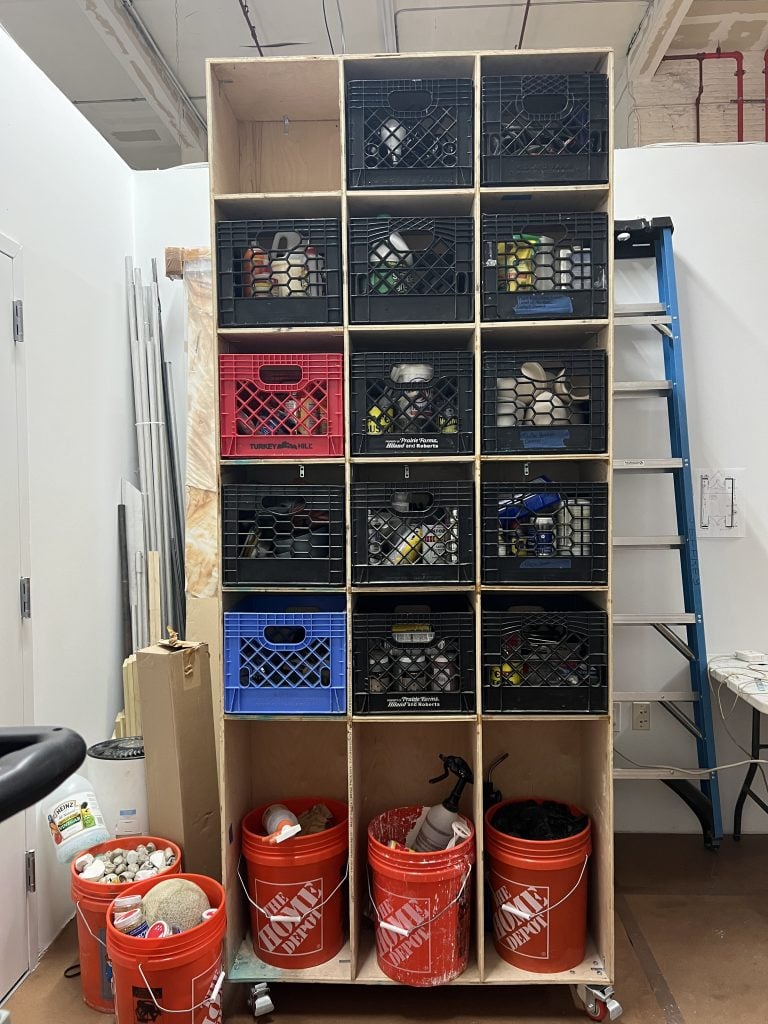
Studio shelf. Courtesy of the artist.
What is the fanciest item in your studio? The most humble?
I have a custom-made wooden shelf that doubles as storage and as mobile walls. It fits 15 milk crates in a three-by-five configuration and three five-gallon buckets on the bottom.
I also have two folding plastic tables.
What’s the last thing you do before you leave the studio at the end of the day (besides turning off the lights)?
I write a list of things that I’d like to accomplish the following day.








